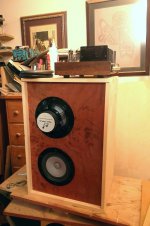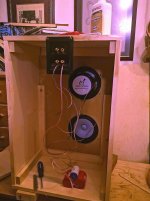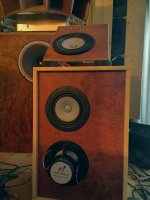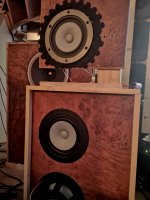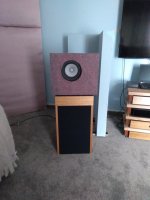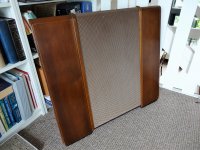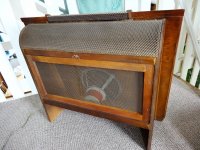I've been running a pair of Peerless 830669 (12 in. woofers) per side on a traditional open baffle for at least a couple years now. With a Qts ~.54 and some (Mini DSP ) EQ they are capable and enjoyable.
Don't get too hung up on high Qts. That parameter is a bit outdated. Bi or tri amping with DSP is the way to go. Price out active vs. a 3 way passive X/O with decent components for an open baffle and...
Don't get too hung up on high Qts. That parameter is a bit outdated. Bi or tri amping with DSP is the way to go. Price out active vs. a 3 way passive X/O with decent components for an open baffle and...
I've been running a pair of Peerless 830669 (12 in. woofers) per side on a traditional open baffle for at least a couple years now. With a Qts ~.54 and some (Mini DSP ) EQ they are capable and enjoyable.
Don't get too hung up on high Qts. That parameter is a bit outdated. Bi or tri amping with DSP is the way to go. Price out active vs. a 3 way passive X/O with decent components for an open baffle and...
I agree with you. I was injured at work a while ago, and limited hours means limited...means.
I'll be sticking with my active crossovers, without DSP. I've found choosing a crossover point in the midrange, at its dipole peak, and splitting it between two drivers passively, is an easy way of flattening response.
Usually I start with a Solen Split calculator at the desired frequency, and widen the -3db points further apart, if necessary.
Cuts down on amps, too.
Still trying out various crossover points, in my 3 way plus sub, to get the controlled beaming I'm after, to limit sidewall reflections.
Slow going, without the ability to do more than a handheld sound meter measurement set of readings.
Fun, though.
It gets tedious with subjective impressions varying day by day, with material, and time away from a loud job.
My thanks to the departed Mr. Linkwitz, for providing the idea of passively splitting the midrange in an active system.
I covered the 21” baffles of my OB tangband w8-1808 with two airgap separated layers of 3/16” felt. I perceive a big clarity improvement.
Got the idea from a member here (forgot name, my apologies). Got me to thinking again.
I have seen some folks using printed waveguides for tweeters, and was wondering if there’s anyone who has investigated same for fullrangers? Is there an ideal shape?
Got the idea from a member here (forgot name, my apologies). Got me to thinking again.
I have seen some folks using printed waveguides for tweeters, and was wondering if there’s anyone who has investigated same for fullrangers? Is there an ideal shape?
MITsound,
I'm sorry to hear about your injury. I agree with you on the -3dB spacing in the crossover. Even though I'm using a mini dsp I still use Windows Passive Crossover Designer to mock up my filters. The X/O point between my mids and tweets are pretty far apart: 3.7 Khz 3rd order on the mid and 6.9 Khz 3rd order on the tweeter. Sums flat @ 5.6 Khz. Without Win PCD I can't imagine if I would ever have arrived at those numbers by just going at it blindly.
I'm sorry to hear about your injury. I agree with you on the -3dB spacing in the crossover. Even though I'm using a mini dsp I still use Windows Passive Crossover Designer to mock up my filters. The X/O point between my mids and tweets are pretty far apart: 3.7 Khz 3rd order on the mid and 6.9 Khz 3rd order on the tweeter. Sums flat @ 5.6 Khz. Without Win PCD I can't imagine if I would ever have arrived at those numbers by just going at it blindly.
I am guilty of seeking pleasant colorations.MITsound,
I'm sorry to hear about your injury. I agree with you on the -3dB spacing in the crossover. Even though I'm using a mini dsp I still use Windows Passive Crossover Designer to mock up my filters. The X/O point between my mids and tweets are pretty far apart: 3.7 Khz 3rd order on the mid and 6.9 Khz 3rd order on the tweeter. Sums flat @ 5.6 Khz. Without Win PCD I can't imagine if I would ever have arrived at those numbers by just going at it blindly.
I prefer a shallow dip.centred at around 4000 hertz.
That range just bugs me.
I also find I usually get better imaging, if I put another shallow dip in around 900 to 11000 hertz.
I am guilty of seeking pleasant colorations.
I prefer a shallow dip.centred at around 4000 hertz.
That range just bugs me.
I also find I usually get better imaging, if I put another shallow dip in around 900 to 11000 hertz.
I understand completely. 1.5-3 Khz is my white whale. I'm a "The music lives in the midrange" kinda guy and I do not like aggressive voicing in that area.
Having said that, I am currently giving my mids a little 1.8 -2 Khz cuz they just need it. I'm also pretty sure I've got some (narrow Q) 900Hz pulled out as well. Boundaries and room gain and all that may cause your results to vary wildly.
Sounds to me, though, that we are kinda on the same page (same chapter?) on the sound signature that we enjoy. Relaxed mids, clean bass, and highs that make me forget that they are there.
Don't get me started on sibilance.
MarkAudio U Frame
Starting a build similar in principle to the LX521 .
Mine are intended as satellites with a slot loaded open baffle sub I already have.
I want plenty of power response from 120 to 1000 hertz or so, and I figure this will do that, as well as cleaning up already good bass, up to 300 hertz or so.
On top , I'll use a tilted towards ceiling 12P, relying on beaming to filter the highs.
I've done this before, with some nice but fragile Seas Alnico 21TV drivers.
It eliminates a lot of back wall reflection issues.
Since I don't mind the focus a little beaming brings, I'll be using a 7P for treble, pointing straight ahead, at least to start with.
The 12P and 7P will share a head unit, which can pivot independent of the lower U Frame.
Hoping to get most of one channel going tonight. I guess ideally, these drivers will already be good enough on midbass to make push pull moot.
I do like the utilitarian look of it, though.
Starting a build similar in principle to the LX521 .
Mine are intended as satellites with a slot loaded open baffle sub I already have.
I want plenty of power response from 120 to 1000 hertz or so, and I figure this will do that, as well as cleaning up already good bass, up to 300 hertz or so.
On top , I'll use a tilted towards ceiling 12P, relying on beaming to filter the highs.
I've done this before, with some nice but fragile Seas Alnico 21TV drivers.
It eliminates a lot of back wall reflection issues.
Since I don't mind the focus a little beaming brings, I'll be using a 7P for treble, pointing straight ahead, at least to start with.
The 12P and 7P will share a head unit, which can pivot independent of the lower U Frame.
Hoping to get most of one channel going tonight. I guess ideally, these drivers will already be good enough on midbass to make push pull moot.
I do like the utilitarian look of it, though.
Attachments
Less and more?
As hoped, the relative to driver width deeper than normal U-Frame has some audible resonances in male vocals.
A 1 slope filter at 110 hertz or so eliminates this, in addition to the already present 4 Slope digital filter from my preamp, set for 120 hertz.
Got my new cheap wire in today, so rewired things more neatly. ( The previous was mix and mismatched scraps).
I noticed right away, the 16 gauge Amazon Basics isn't. At least on both sides: after stripping the insulation, the black insulated wire twists up much thicker pre crimping the connectors on, than the clear insulated side.
I'm not sure if they are following the Eichmann Ratio thing, but thought it may be of interest to any cable disciples looking for a good deal.
Got a fifty foot roll for $11 Canadian funds with free delivery, it being part of a larger order.
Easy to use, and seems annealed.
As hoped, the relative to driver width deeper than normal U-Frame has some audible resonances in male vocals.
A 1 slope filter at 110 hertz or so eliminates this, in addition to the already present 4 Slope digital filter from my preamp, set for 120 hertz.
Got my new cheap wire in today, so rewired things more neatly. ( The previous was mix and mismatched scraps).
I noticed right away, the 16 gauge Amazon Basics isn't. At least on both sides: after stripping the insulation, the black insulated wire twists up much thicker pre crimping the connectors on, than the clear insulated side.
I'm not sure if they are following the Eichmann Ratio thing, but thought it may be of interest to any cable disciples looking for a good deal.
Got a fifty foot roll for $11 Canadian funds with free delivery, it being part of a larger order.
Easy to use, and seems annealed.
Attachments
Different but done
No need for the planned Alpair 7P to be included. Plenty of extended sound from the angled open baffle 12P. Without the tilt, this driver seemed slightly harsh to me in open baffle.
I guess off axis reduced the harshness as planned, but I'm surprised there's enough presence and treble like this. The 7P will await another project.
The 12P sports just a 2.2uF Ampohm papering wax tinfoil cap.
No more active crossovers here, it sounds more pleasant just passively filtered.
No need for the planned Alpair 7P to be included. Plenty of extended sound from the angled open baffle 12P. Without the tilt, this driver seemed slightly harsh to me in open baffle.
I guess off axis reduced the harshness as planned, but I'm surprised there's enough presence and treble like this. The 7P will await another project.
The 12P sports just a 2.2uF Ampohm papering wax tinfoil cap.
No more active crossovers here, it sounds more pleasant just passively filtered.
Attachments
Baffle Treatment
I reorientated the top baffle vertically, to hear if the 12P sounds better in a conventional mounting.
It may, with a LPad, but I don't want one in circuit.
I also tried a quick experiment to hear if a patterned non reflective felt treatment around the driver, matching its non flush mounted rise would help things out, and it does, but not enough for me.
Back to the tilt.
I reorientated the top baffle vertically, to hear if the 12P sounds better in a conventional mounting.
It may, with a LPad, but I don't want one in circuit.
I also tried a quick experiment to hear if a patterned non reflective felt treatment around the driver, matching its non flush mounted rise would help things out, and it does, but not enough for me.
Back to the tilt.
Attachments
I have tried similar approach and can confirm it works great.
Do you mean the felt stickers, or the tilted baffle?
For me the felt covered baffle provided a huge improvement in detail with the 12P's, I have the felt cover the whole baffle to attenuate reflections from the edge. I covered them in speaker fabric so you can't see the felt now. I would like to have the baffle the same width as the woofer but they sound so good I'm hesitant to make any changes.
Attachments
For me the felt covered baffle provided a huge improvement in detail with the 12P's, I have the felt cover the whole baffle to attenuate reflections from the edge. I covered them in speaker fabric so you can't see the felt now. I would like to have the baffle the same width as the woofer but they sound so good I'm hesitant to make any changes.
I tried this after seeing you had done it...same thing, a big detail improvement with the tangband w8-1808.
Do you mean the felt stickers, or the tilted baffle?
The tiltet approach. I used felt, but on the full surface
OB "omni" experiment
Last edited:
I understand the discussion is about open baffle and not necessarily dipoles exactly, but I'm wondering if using felt effects the radiation reaching the baffle edge such that the cancellation is compromised?
Yeah, I don’t know precisely why it makes such a difference in my case, but it does.
I think about a pressure wave attempting to propagate to baffle edge...weakened as it travels (but not the back wave). By baffle edge, the effect is much reduced.
3” of rock wool insulation is effective down to 200 hz. So Ikm imagining a curved fullrange baffle that looks from the front to be flat because the void is filled with rockwool. A perfectly dead, non resonant baffle.
Gotta try that. Soon.
Re-foamed all three in this old beauty a few years back. I expect someone already posted one but most of the pics seem to be absent so I thought - what the heck....
Perfect! This was supposed to be gallery thread after all.
- Home
- Loudspeakers
- Multi-Way
- Ultimate Open Baffle Gallery
